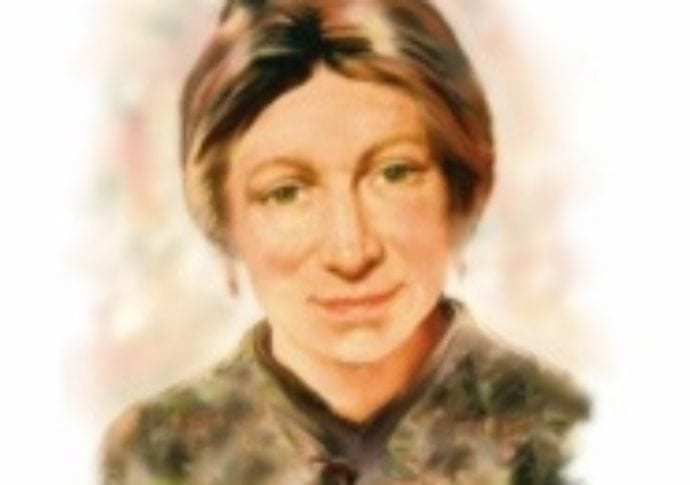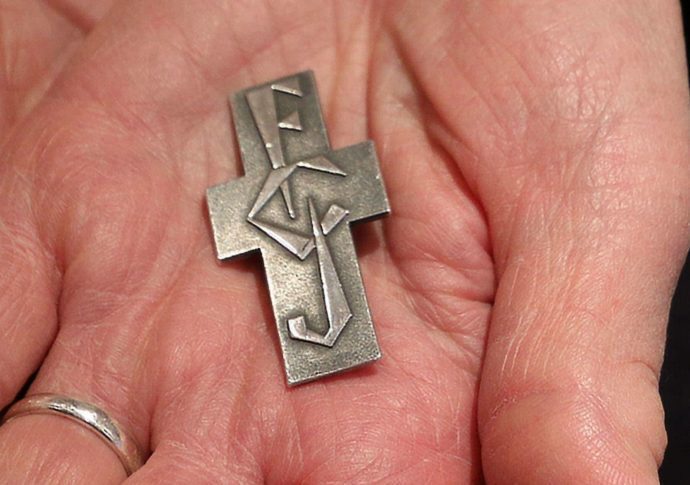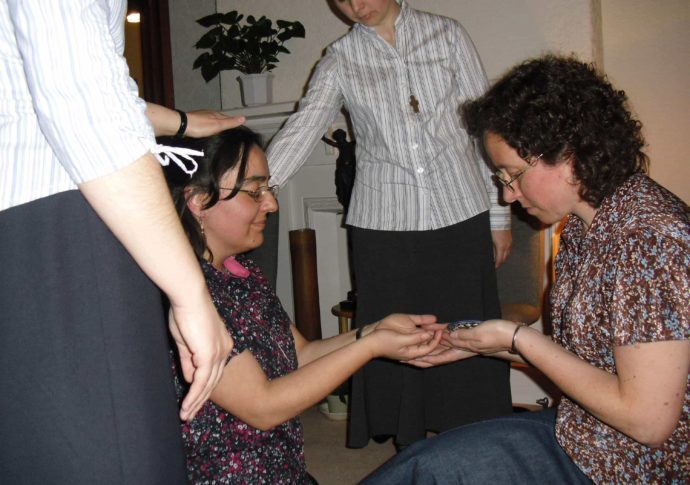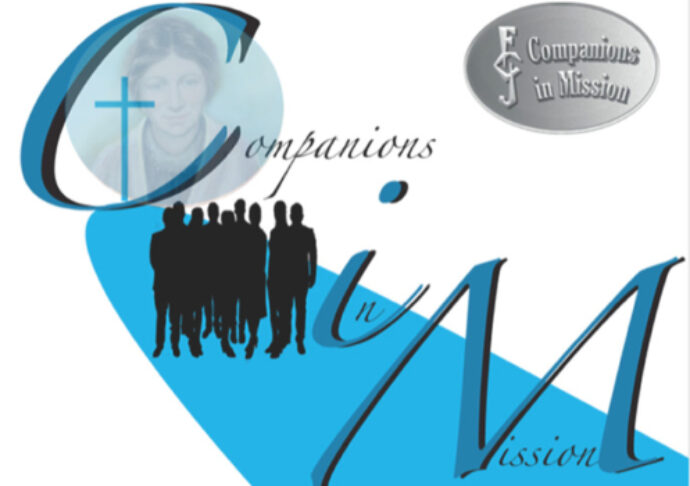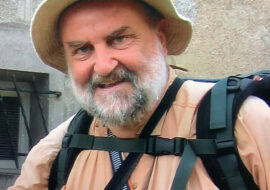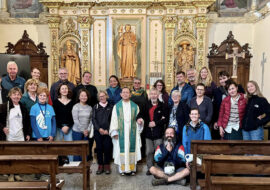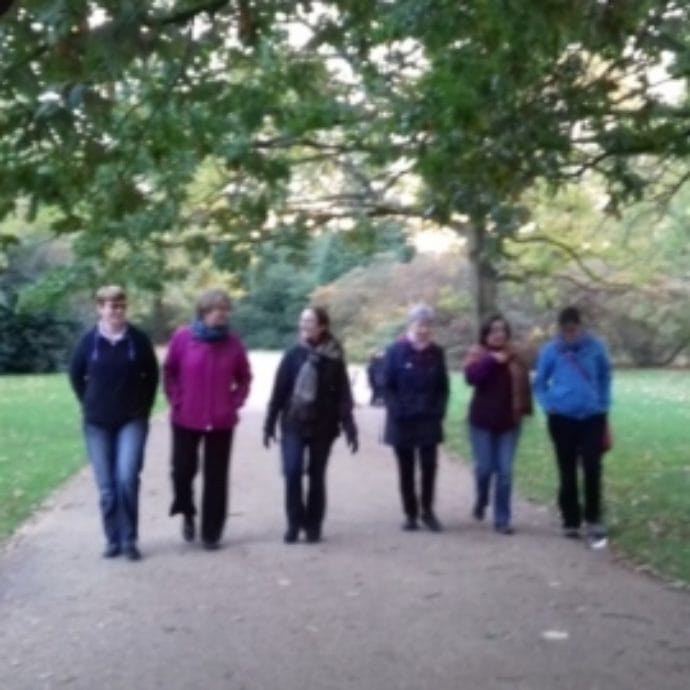Walking has become, over the last few years, the physical exercise of choice, at least for those who avoid anything more vigorous. It has also been, as Sr Teresa White fcJ demonstrates here, a spiritual practice for centuries, in forms as diverse as treading the contemplative path of a labyrinth to joining the crowds on a long-distance pilgrimage. This article was first published in The Way, an international journal of contemporary Christian spirituality, published by the British Jesuits.
In modern times, we have seen increasing pedestrianisation in city centres – a process that seems unlikely to be reversed any day soon. Although this may have been carried out mainly to boost the economy by facilitating access to shops and other businesses, indirectly, we all benefit from it, because it forces us to do a bit more walking. There is something inherently ‘civilised’ about walking around town, as opposed to zooming about in motor vehicles, endangering pedestrians and cyclists and endlessly polluting the atmosphere! Interestingly, notwithstanding the numerous gyms, mental and physical disciplines and diets designed to facilitate fitness and good health, many doctors say that – all other things being equal – walking, our most natural form of bodily exercise, i.e. regular, un-stressful walking, is probably as good for us as anything. So, they suggest, if you’re travelling by bus or tube or metro, why not get off a stop or two before your destination and walk the rest of the way? As for the car, avoid using it whenever possible, and if you can sensibly go from A to B by shanks’ pony, do so! Sometimes, it is no bad thing to remember that, for most of human history, relatively few people possessed a horse or chariot so walking was the main means of locomotion – and presumably still is for many inhabitants of our planet. In the ancient Middle Eastern countries, it seems people thought nothing of walking forty miles in a day, carrying only a gourd. This they would fill with water from a stream, picking and eating grasses and the fruits of bushes and trees as they walked.
 Walking – much easier to demonstrate than describe – is the process of moving forward by lifting one foot entirely, then allowing it to touch the ground while raising the other foot to repeat the action. Slightly bending the knee comes into it, and a rhythmical swing can make it a pleasurable experience… But this uninspiring explanation is very far from encompassing the profound significance of walking for us humans. Rhythm, the beating of the heart, is our lifeline and the act of walking in some sense echoes and affirms this rhythm. Typically, we learn the skill at about the age of 12 months, and after taking our first hesitant steps (to the applause of our delighted parents) it rapidly becomes second nature to us. Most of us then carry on walking with confidence and nonchalance until a sprained ankle, arthritis or some other physical ailment or disability makes us realise just how vital walking is to so many aspects of our lives and to our general sense of wellbeing. How we miss it when we are unable to do it easily, when each step exacts pain and effort on our part! Practical, down-to-earth (literally), walking is the indispensable prelude to more charismatic bodily activities such as dancing and sport – you have to learn to walk before you can run or jump or tango!
Walking – much easier to demonstrate than describe – is the process of moving forward by lifting one foot entirely, then allowing it to touch the ground while raising the other foot to repeat the action. Slightly bending the knee comes into it, and a rhythmical swing can make it a pleasurable experience… But this uninspiring explanation is very far from encompassing the profound significance of walking for us humans. Rhythm, the beating of the heart, is our lifeline and the act of walking in some sense echoes and affirms this rhythm. Typically, we learn the skill at about the age of 12 months, and after taking our first hesitant steps (to the applause of our delighted parents) it rapidly becomes second nature to us. Most of us then carry on walking with confidence and nonchalance until a sprained ankle, arthritis or some other physical ailment or disability makes us realise just how vital walking is to so many aspects of our lives and to our general sense of wellbeing. How we miss it when we are unable to do it easily, when each step exacts pain and effort on our part! Practical, down-to-earth (literally), walking is the indispensable prelude to more charismatic bodily activities such as dancing and sport – you have to learn to walk before you can run or jump or tango!
In religious rituals, spiritual realities are frequently represented by familiar things, taken from nature or from life as we know it: water, oil, bread and wine. These things are part of our lives – they precede the spiritual meanings we give to them. So yes, in human experience, what comes first is not the spiritual but the material or physical. Yet we live in both realms, and walking in some sense seems to unite the two, for though manifestly a physical activity, it can be a spiritual experience also. The cosmos is our meeting place with God, in whom we live and move and have our being (Acts 17:28), and when we walk in our world, God’s world, the ground beneath our feet is sacred, for God, as Paul Tillich famously said, is the ground of being. St Paul adds another dimension to the act of walking: We walk by faith and not by sight, he says (2 Cor. 5: 7). Walking by faith, walking reflectively, a person may discover his or her true identity and vocation. Because of this, from the earliest times, walking – not running, jogging, dancing or leaping, but travelling on foot, with a kind of reverence and at a moderate pace – became a metaphor for a privileged time of ‘encounter’: with self, with others, and above all, with God. There is undoubted wisdom in the Latin tag, Solvitur ambulando – ‘it (a difficulty, a misunderstanding) is solved by walking’. From my own experience, I could not count the number of problematic situations that have been eased or solved by people agreeing to go for a walk together to talk things through…
Ambulatories and Labyrinths
Cathedrals and churches often contain what are technically called ambulatories, or aisled spaces on either side of the nave and round the apse to form a continuous processional walkway. In a mediaeval monastery, the ambulatory or covered walkway surrounded an enclosed garden (cloister), and the monks or nuns, as they walked round it, would read and pray and reflect. It is thought that the labyrinths found in certain French cathedrals may have been created for a similar purpose: to aid spiritual growth by walking and prayer. Today, the only original labyrinth that remains intact is in the nave of Chartres Cathedral, many others having been torn up during the political troubles of 18th and 19th century France, although some, like the one in Amiens cathedral, have been reconstructed. Although the labyrinth with its strange patterns is not a Christian symbol in itself – its amazing design has been found carved into rocks dating back to prehistoric times, thousands of years ago – the fact that it was incorporated into churches suggests that it must have had a Christian purpose. A common theory is that walking the labyrinth gave to people who could not undertake the lengthy journey to Rome or Compostela or Jerusalem, the opportunity to make a symbolic pilgrimage: all they had to do was simply walk through the entry space and then prayerfully follow the path to the centre.
 Labyrinth here is not to be understood in its original sense, as a complicated cluster of pathways like those in the place of confinement of the mythical Cretan monster, the Minotaur; nor does its modern meaning apply either, for the mediaeval labyrinth is not just a brain-teaser, a baffling jumble of multiple paths lined, like the maze at Hampton Court, with high hedges. The Chartres labyrinth, circular, flat and marked out in black and white marble, is set into the paving stones of the floor of the cathedral. There is only one route to follow, a clear though intricate route, which leads from the circumference to the centre. Unlike Theseus, who needed Ariadne’s thread to find his way out of the Cretan labyrinth, the walker following this path cannot get lost: there are no junctions, no dead ends, no choices to be made. Interestingly, walking the labyrinth, a practice which has experienced a revival in recent times, among Christians and New Age enthusiasts alike, is often used today as a meditative exercise representing the journey, both literal and metaphorical, to our own centre and out into the world again.
Labyrinth here is not to be understood in its original sense, as a complicated cluster of pathways like those in the place of confinement of the mythical Cretan monster, the Minotaur; nor does its modern meaning apply either, for the mediaeval labyrinth is not just a brain-teaser, a baffling jumble of multiple paths lined, like the maze at Hampton Court, with high hedges. The Chartres labyrinth, circular, flat and marked out in black and white marble, is set into the paving stones of the floor of the cathedral. There is only one route to follow, a clear though intricate route, which leads from the circumference to the centre. Unlike Theseus, who needed Ariadne’s thread to find his way out of the Cretan labyrinth, the walker following this path cannot get lost: there are no junctions, no dead ends, no choices to be made. Interestingly, walking the labyrinth, a practice which has experienced a revival in recent times, among Christians and New Age enthusiasts alike, is often used today as a meditative exercise representing the journey, both literal and metaphorical, to our own centre and out into the world again.
Scripture
Scripture readily mingles history and theology, and its wide-ranging narratives reflect both elements. Walk in my presence and be blameless (Gen. 17: 1), said God to Abraham, and from very early on, the biblical notion of walking in God’s presence, following God’s ways, held a strong metaphorical significance for the people of Israel. So we see them on their journey to the Promised Land making the progressive discovery that God ‘walks’ with them, accompanying them, guiding them along the ‘right’ path. Sometimes they lose sight of that presence and come to grief. But overall, when the writers of the Hebrew Bible describe the long peregrinations of their nation, they see these as times when God is testing and forming them. The Torah, was not just a law, it was ‘the way’ that God’s people were called to walk, following the divine commandments. As they walked that path, they deepened their relationship with God and with their community, and they learned from experience that God’s fidelity would not fail them.
In the New Testament also, especially in the letters of Paul, there are frequent references to walking in this metaphorical sense, as he urges the first Christians to walk ‘in the Spirit’, to walk the path of life in love, in light, in truth, and with integrity.

In the Bible, it is possible to discern a kind of dialectic between the sedentary and the nomadic, and the notion of walking is sometimes presented as an antidote to a settled, stable existence where a person or tribe puts down roots and stays in one place for a long time, accumulating wealth and possessions. Jesus’ parable about the Rich Fool (Luke 12: 16 – 21), who set about building more and more barns to store his abundant crops, echoes this tension: such people think they can get on alone – that they don’t need God’s help. Nomads and travellers, on the other hand, always on the move, their only shelter a flimsy tent, are conscious of their weakness and fragility. Poor in spirit, they recognise their vulnerability and know their need of God. There is an asceticism or spiritual discipline involved in moving away from home and familiar things in order to follow God’s call, and the experience of pilgrimage calls for a similar attitude of detachment. Thus the inner disposition required of the pilgrim is a sort of spiritual poverty, trust in God, not in material things. In addition, the pilgrim routes were notoriously hazardous. Because of this, wealthy people sometimes preferred not to make the journey themselves but to pay others to represent them at a shrine – indeed the story goes that in 1352 a London merchant left a man £20 (a huge sum of money at the time) in his will to go on a pilgrimage to Mount Sinai on his behalf!
Travelling to a common destination by any means of transport – car, train, plane, bus – can generate a sense of companionship, especially if there is an unexpected delay or a problem arises. However, the stated purposefulness of such modes of transport – to get the traveller to a given destination as quickly as possible and within certain time limits – means that the element of ‘unhurriedness’ that seems to be integral to walking in the biblical sense, is often missing. Contemplative walking on the other hand is akin to the idea of pilgrimage, which symbolises humankind’s search for meaning in life and is a powerful reminder of the importance of spiritual realities. Going on pilgrimage, making one’s way to a holy place, alone or with others, in order to seek forgiveness or pray for spiritual and temporal favours, was a very popular religious practice throughout mediaeval Europe. It declined in the sixteenth century, when the whole idea was scorned by the reformers, who considered pilgrimages to be a ‘popish’ custom, in their view akin to the ‘selling’ of indulgences, since money was demanded by the keepers of the shrines, which often contained somewhat dubious relics. Nevertheless in spite of the reformers’ zeal, the Black Death and political obstacles such as war, the practice of Christian pilgrimages never completely died out, especially in continental Europe. Today many people continue to undertake them, and of course the notion of a ‘sacred journey’, when the spiritual quest is expressed in a physical journey to a holy place, is found in all faith traditions.
God does not hide himself from those who seek him with a sincere heart, even though they do so tentatively, in a vague and haphazard manner.
Pope Francis, Evangelii Gaudium §71
Seeking God, seeking the holy, is at the heart of the idea of pilgrimage, and ‘God’, says Pope Francis, ‘does not hide himself from those who seek him with a sincere heart, even though they do so tentatively, in a vague and haphazard manner’(Evangelii Gaudium §71). Pilgrims often say that there is something special about walking alongside another person or with a group of people to a shrine: walking together seems to generate dialogue, intimacy, mutual pleasure, mutual help and support, instinctive cooperation. And it has a ‘levelling’ effect, as people walking together are reduced to that fundamental human condition of moving forward with one another on the ground. We see this in The Canterbury Tales, in which Chaucer used the occasion of a pilgrimage to the most popular shrine in England to bring together people from various classes of society for the reader’s edification and entertainment. Chaucer’s pilgrimage remained an unambiguously ‘religious’ journey – however secular the preoccupations and subsequent actions of the characters may have been!

Recently, when I visited Notre Dame Cathedral in Paris, inside, just near the main door, I saw a large plaque inscribed with the words: VIA VIATORES QUAERIT (translation from the Latin was given in three languages: Je suis la voie qui cherche des voyageurs, Yo soy el camino que busca viajeros, and I am the way which seeks travellers). I discovered that in 2013, during the celebrations marking 850 years since the construction of Notre Dame began in 1163 (it was completed some 200 years later), one of the commemorative events organised by the diocese of Paris was a pilgrimage. The organisers took the theme VIA VIATORES QUAERIT, and it seems that hundreds of people, young and old, took part in that pilgrimage, coming to Notre Dame on foot and by various other forms of transport from all over France and further afield. Since then, each year, during the summer months, the cathedral has continued to display that plaque for the benefit of the Compostela pilgrims, many of whom pass through Paris on their way to Spain. Near the plaque, in the accompanying blurb, I noticed that the words were attributed to St Augustine of Hippo, but Augustine’s actual words (which I looked up on my return home) were: ‘Nostra via ambulatores quaerit – our way (i.e. our Christian way, the way of Jesus Christ) seeks walkers. This is a classic biblical notion, clearly expressed in Psalm 127: Oh blessed are those who fear the Lord, and walk in his ways. I was reminded of a South African Zulu chant, Siahamba, whose words have the same message, echoing 1 John 1: 7: We are walking in the light of God …
 On the mainland of Europe, pilgrimages to the shrine of St James at Compostela began very soon after the tomb believed to contain the saint’s relics had been rediscovered in 814 AD, and over many centuries, a large number of the pilgrims came from France (joined by many too from England), and Notre Dame was the starting point for the pilgrimage. The Kingdom of France provided protection and freedom along the pilgrimage routes to this shrine, known as the Camino de Santiago (the ‘Way of St James’). The names of a surprisingly large number of Paris streets and districts reflect the popularity of this pilgrimage, and the emblem worn by the pilgrims, their ‘badge’, the so-called coquille Saint Jacques (a scallop shell), is engraved on some of the buildings along the traditional route through the city. In the Middle Ages, pilgrims often walked for months or even years through France and northern Spain to reach their destination, sleeping in huts and barns or in the open. It was a risky undertaking, and they often went in groups as a protection against thieves and brigands. On the way, pilgrims would present themselves at churches, castles, abbeys, farms and ordinary homes, rich and poor, where they could expect to be given as much sustenance as they could pick up with one scoop of the coquille. In this way, even the poorest household could, without being overburdened, offer charity to the pilgrims, who would be given oats or barley or perhaps beer or wine. All this happened in mediaeval times. However, in spite of periods of decline, this pilgrimage has always attracted people, and in 2017, over 300,000 pilgrims from different parts of the world made their way to Santiago. Many of these would have used various forms of transport at different stages of the journey, but still, for the vast majority of the pilgrims, young and old, walking continues to play an important part in the whole experience of the Camino.
On the mainland of Europe, pilgrimages to the shrine of St James at Compostela began very soon after the tomb believed to contain the saint’s relics had been rediscovered in 814 AD, and over many centuries, a large number of the pilgrims came from France (joined by many too from England), and Notre Dame was the starting point for the pilgrimage. The Kingdom of France provided protection and freedom along the pilgrimage routes to this shrine, known as the Camino de Santiago (the ‘Way of St James’). The names of a surprisingly large number of Paris streets and districts reflect the popularity of this pilgrimage, and the emblem worn by the pilgrims, their ‘badge’, the so-called coquille Saint Jacques (a scallop shell), is engraved on some of the buildings along the traditional route through the city. In the Middle Ages, pilgrims often walked for months or even years through France and northern Spain to reach their destination, sleeping in huts and barns or in the open. It was a risky undertaking, and they often went in groups as a protection against thieves and brigands. On the way, pilgrims would present themselves at churches, castles, abbeys, farms and ordinary homes, rich and poor, where they could expect to be given as much sustenance as they could pick up with one scoop of the coquille. In this way, even the poorest household could, without being overburdened, offer charity to the pilgrims, who would be given oats or barley or perhaps beer or wine. All this happened in mediaeval times. However, in spite of periods of decline, this pilgrimage has always attracted people, and in 2017, over 300,000 pilgrims from different parts of the world made their way to Santiago. Many of these would have used various forms of transport at different stages of the journey, but still, for the vast majority of the pilgrims, young and old, walking continues to play an important part in the whole experience of the Camino.
Wandering
Is wandering is a kind of poetic expansion or extension of the act of walking? I think it may be. Wandering involves moving in a leisurely way, walking in a relaxed way, with no plan or definite purpose, and it seems to encourage a more contemplative gaze, so that we learn to look upon commonplace things with a greater intensity and understanding. As we wander, we sometimes come upon new and exciting pathways in what had seemed to be shadowy landscapes. Sudden moments of insight and liberation are not rare, as Wordsworth well knew. It was while he wandered, as he says in his famous poem, lonely as a cloud, that he saw that host of golden daffodils, fluttering and dancing in the breeze. And he never forgot them. It seems that when such epiphanies flash upon the inward eye, a wave of hopefulness and unexplained joy washes over us. Afterwards, we can tune in to that joy and be spiritually nourished by it whenever it comes to into our minds.
Wandering and wondering seem to be closely linked in our human experience. The words of John Jacob Niles’ American folk hymn gracefully articulate this link: I wonder while I wander out under the sky… While wandering, at the same time we are often drawn to ponder on the deeper questions about who we are and why we are here. If, as R. S. Thomas said, the relationship with God is living between doubt and certainty, reflective wandering can help us to be more open to intimations of the divine in both ordinary and challenging situations, to cling to hope in times of suffering, to seek meaning in the often chaotic human journey.
Wandering and wondering in this way can lead us to disentangle ourselves from the fast-moving narrative of our lives and to relish moments of grace and transcendence in the midst of the hazards and risks, the perplexities and uncertainties that many people have to face each day.
Creativity
Pilgrimage, journeying to a holy place, or the more poetic activity of wandering, are very far from being the only reasons why walking is so important to us. Many a writer or composer or painter has found walking to be an essential stimulus to creative ideas. Nietzsche would certainly not disagree: All great thoughts are conceived by walking, he said. I once read that Ian McEwan spends hours walking and ruminating before beginning to write one of his novels, and it would not surprise me to hear that other writers do the same, and composers too. Benjamin Britten is a case in point: it is a well-known fact that, walking on the beach at Aldburgh, he would work out an entire musical score in his head before setting it down on paper. It seems that J.S. Bach was also a walker, and an intrepid one – he once took a month off from his musical duties to walk the 250 miles from Arnstadt to Lubeck, in order to hear the famous Buxtehude giving an organ recital!
Marching
As for the Jarrow marchers, in 1936, they walked all the way from Tyneside to London, carrying a petition to the British government requesting the establishment of a new industry in their town after the closure of their shipyard. They received food and hospitality on the way and a public welcome awaited them on their arrival in London. The government received their petition, but to the men’s intense frustration and distress, did not debate it, so they returned home believing they had failed. But their long walk had made a deep impression on the nation, and is thought to have helped foster changes in our attitude to the poor and the unemployed that led to some of the major social reforms that followed the Second World War in Britain.
Treading Gently
 And when we think of that terrible war, it is perhaps salutary also to remember how many maimed, wounded and dead human beings would never walk again as a result of it. Perhaps we can comfort ourselves with the hope that, if all that unprecedented misery and destruction had any ultimate saving grace, it may well have been to make us more sensitive to any kind of suffering, and to have helped to change our way of relating not only to other human beings, but to the earth we walk upon. For example, in recent years, many people, perhaps especially the young, have become more conscious of humanity’s contribution to the present ecological crisis and they desire to make amends. Generations have trod, have trod, have trod, said Gerard Manley Hopkins, And all is seared with trade; bleared, smeared with toil. But, the poet continues, There lives the dearest freshness deep down things. Recognising the importance of that freshness, we are slowly learning that we need to walk more gently upon the earth. Our increased understanding of and respect for the workings of nature has led some to choose a simpler lifestyle, marked, in the words of Pope Francis, by moderation and the capacity to be happy with little (Laudato si’ §222). We are learning too to expand our moral concern and to see our human needs as part of a spectrum that includes plants, animals, air, water and soils. After all, as Pope Francis says in another document, We human beings are not only the beneficiaries but also the stewards of other creatures. Thanks to our bodies, God has joined us so closely to the world around us that we can feel the desertification of the soil almost as a physical ailment, and the extinction of a species as a painful disfigurement. Let us not leave in our wake a swath of destruction and death which will affect our own lives and those of future generations (Evangelii Gaudium §215). We still have far to go, but many of us are making more conscious and concerted efforts to walk on the earth, God’s earth and our common home, with greater sensitivity, more intensely aware of our relationship with one another and with the natural world which nurtures and sustains us.
And when we think of that terrible war, it is perhaps salutary also to remember how many maimed, wounded and dead human beings would never walk again as a result of it. Perhaps we can comfort ourselves with the hope that, if all that unprecedented misery and destruction had any ultimate saving grace, it may well have been to make us more sensitive to any kind of suffering, and to have helped to change our way of relating not only to other human beings, but to the earth we walk upon. For example, in recent years, many people, perhaps especially the young, have become more conscious of humanity’s contribution to the present ecological crisis and they desire to make amends. Generations have trod, have trod, have trod, said Gerard Manley Hopkins, And all is seared with trade; bleared, smeared with toil. But, the poet continues, There lives the dearest freshness deep down things. Recognising the importance of that freshness, we are slowly learning that we need to walk more gently upon the earth. Our increased understanding of and respect for the workings of nature has led some to choose a simpler lifestyle, marked, in the words of Pope Francis, by moderation and the capacity to be happy with little (Laudato si’ §222). We are learning too to expand our moral concern and to see our human needs as part of a spectrum that includes plants, animals, air, water and soils. After all, as Pope Francis says in another document, We human beings are not only the beneficiaries but also the stewards of other creatures. Thanks to our bodies, God has joined us so closely to the world around us that we can feel the desertification of the soil almost as a physical ailment, and the extinction of a species as a painful disfigurement. Let us not leave in our wake a swath of destruction and death which will affect our own lives and those of future generations (Evangelii Gaudium §215). We still have far to go, but many of us are making more conscious and concerted efforts to walk on the earth, God’s earth and our common home, with greater sensitivity, more intensely aware of our relationship with one another and with the natural world which nurtures and sustains us.





